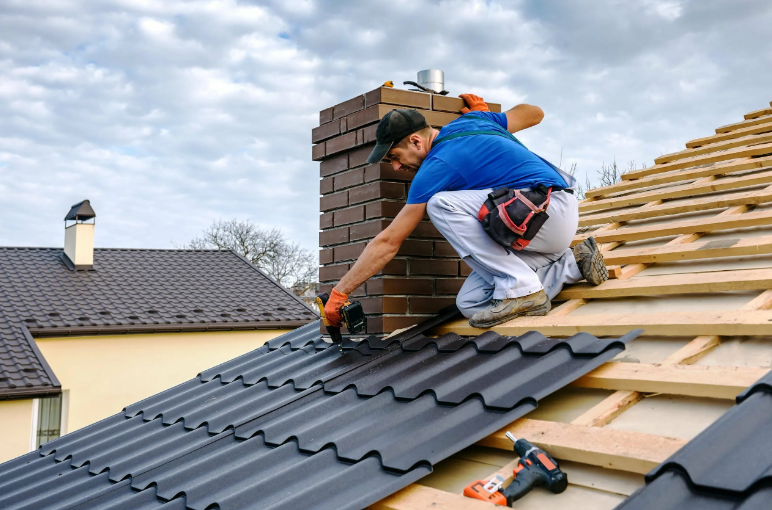
How Summer Heat Affects Your Roof and What You Can Do About It
When summer rolls in, most people think of vacations, barbecues, and pool days. But there’s one part of your home that dreads the summer sun — your roof. Scorching temperatures, UV rays, and thermal expansion can do more damage than you might expect. If you’re a homeowner, understanding how summer heat affects your roof is crucial for prolonging its lifespan and protecting your investment.
In this blog, we’ll break down the real impact of hot weather on roofing materials, explain warning signs of damage, and give you practical tips to keep your roof in top shape. If you’re in need of a reliable roofing professional, companies like Over and Above Contracting are here to help with expert repairs and maintenance.
Why Your Roof Suffers in the Summer
Your roof is like the first line of defense against the elements. In the summer, it gets hit with more than just a bit of sunlight — it absorbs intense heat, copes with sudden weather changes, and endures UV radiation, all of which can cause serious wear and tear over time.
1. Extreme Temperatures Lead to Expansion and Contraction
When the temperature soars during the day and drops at night, your roof undergoes thermal expansion and contraction. Roofing materials expand in the heat and contract when it cools down. Over time, this process can:
-
Weaken shingles
-
Create cracks
-
Loosen nails and fasteners
-
Damage flashing and sealants
This constant movement can shorten your roof’s lifespan and increase the risk of leaks and structural damage.
2. UV Radiation Breaks Down Roofing Materials
The sun’s ultraviolet (UV) rays are powerful enough to damage the molecular structure of many materials — and your roof is no exception. Constant exposure to UV radiation can:
-
Fade shingles
-
Make asphalt brittle
-
Weaken protective coatings
-
Cause wooden components to dry and split
Even if your roof looks okay at a glance, UV damage can silently deteriorate its integrity over time.
3. High Humidity and Moisture Retention
In many regions, summer doesn’t just mean heat — it means humidity. High humidity levels can trap moisture underneath shingles or in the attic, creating the perfect environment for:
-
Mold and mildew growth
-
Wood rot
-
Rusted metal components
-
Damaged insulation
If moisture problems go unchecked, they can result in thousands of dollars in repairs. That’s where professionals like Over and Above Contracting can step in for an inspection or attic ventilation solution.
4. Heat Can Raise Attic Temperatures to Dangerous Levels
If your attic isn’t properly ventilated, summer heat can push attic temperatures well above 130°F. This not only makes your home harder to cool but can also:
-
Warp roof decking
-
Bake shingles from the underside
-
Increase your energy bills
Proper attic ventilation, insulation, and radiant barriers can all help regulate temperatures and extend the life of your roofing system.
5. Storms and Hail
Summer often brings sudden thunderstorms, high winds, and even hail. These events can tear shingles off your roof or dent metal surfaces. After any major summer storm, it’s essential to check for:
-
Missing or curled shingles
-
Dents in metal roofs
-
Leaks or water stains on ceilings
-
Debris or clogged gutters
If you’re unsure what to look for, a roof inspection from Over and Above Contracting can help identify hidden damage before it becomes a costly repair.
What You Can Do About Summer Roof Damage
Now that you know how the summer heat affects your roof, let’s talk solutions. With the right proactive steps, you can keep your roof strong and energy-efficient through even the hottest months.
1. Schedule Regular Roof Inspections
One of the smartest moves any homeowner can make is to get a professional roof inspection at least once a year — ideally before or after summer. A licensed contractor can:
-
Spot damage early
-
Check seals and flashing
-
Assess ventilation
-
Recommend small fixes before they become big problems
Consider reaching out to Over and Above Contracting for a comprehensive inspection. They know what signs to look for, especially during and after intense summer weather.
2. Improve Attic Ventilation
Ventilation plays a huge role in protecting your roof from summer heat. A well-ventilated attic can:
-
Keep temperatures balanced
-
Reduce moisture buildup
-
Protect shingles and roof decking
-
Lower your cooling costs
Roof vents, ridge vents, or attic fans can make a big difference in overall performance.
3. Clean Your Gutters
Clogged gutters can trap water and send it under your shingles. In summer storms, this water can quickly lead to rot and mold. Cleaning your gutters (or having them professionally cleaned) is a simple but vital step in roof maintenance.
4. Trim Overhanging Trees
Overhanging branches can scrape shingles, dump leaves in gutters, and break off during storms. Trimming nearby trees will:
-
Prevent debris buildup
-
Reduce shade that encourages mold growth
-
Protect your roof during windstorms
A little preventative landscaping can go a long way in roof protection.
5. Apply Reflective Roof Coating
If you have a flat or metal roof, a reflective coating can help deflect UV rays and reduce heat absorption. These coatings:
-
Extend the life of your roof
-
Improve energy efficiency
-
Lower interior temperatures
Professional contractors like Over and Above Contracting can help apply the right coating to suit your roof type and local climate.
6. Replace Damaged or Aging Shingles
If your shingles are already worn, brittle, or missing granules, summer will only make things worse. Replacing old shingles protects your roof’s structure and ensures better insulation.
Don’t wait until you see a leak or water damage — proactive replacement saves money in the long run.
Signs Your Roof Needs Help This Summer
Here are a few common warning signs that your roof may be suffering from summer damage:
-
Curling or buckling shingles
-
Granules collecting in gutters
-
Dark patches or discoloration
-
High energy bills
-
Water stains on ceilings or walls
-
Musty smells in attic spaces
If you notice any of these, it’s time to call in the professionals. Companies like Over and Above Contracting offer expert repairs, inspections, and even full roof replacements to keep your home protected year-round.
Why Choose Over and Above Contracting?
Choosing the right contractor is just as important as addressing the issue itself. Over and Above Contracting offers:
✅ Local expertise in dealing with extreme weather
✅ High-quality materials designed for longevity
✅ Skilled professionals who care about your home
✅ Fair pricing and trustworthy assessments
✅ Emergency roof repair services after summer storms
Whether you need a quick fix or a full roofing upgrade, they’re equipped to handle every kind of roofing challenge — no matter the season.
Final Thoughts
Your roof might be out of sight, but it shouldn’t be out of mind — especially during the summer months. The intense heat, humidity, and UV rays can silently weaken your roofing system and set you up for expensive problems down the road.
But with regular maintenance, smart ventilation, and the support of a reliable contractor like Over and Above Contracting, you can keep your roof strong, cool, and ready to face whatever the summer throws at it.
FAQs
1. How often should I have my roof inspected during the summer?
It’s ideal to have your roof inspected once a year, but if you live in a high-heat or storm-prone area, you might consider a mid-summer check-up and another after the season ends.
2. Is it safe to walk on my roof in hot weather?
No — shingles can become soft or brittle in extreme heat, and walking on them may cause damage or personal injury. Always hire a professional like Over and Above Contracting for safe roof assessments.
3. Can summer heat really cause a roof leak?
Absolutely. Heat can dry out sealants, crack shingles, and expand materials, leading to gaps where water can get in during a summer storm.




